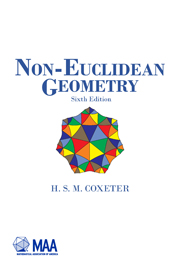Book contents
- Frontmatter
- PREFACE TO THE SIXTH EDITION
- Contents
- I THE HISTORICAL DEVELOPMENT OF NON-EUCLIDEAN GEOMETRY
- II REAL PROJECTIVE GEOMETRY: FOUNDATIONS
- III REAL PROJECTIVE GEOMETRY: POLARITIES, CONICS AND QUADRICS
- IV HOMOGENEOUS COORDINATES
- V ELLIPTIC GEOMETRY IN ONE DIMENSION
- VI ELLIPTIC GEOMETRY IN TWO DIMENSIONS
- VII ELLIPTIC GEOMETRY IN THREE DIMENSIONS
- VIII DESCRIPTIVE GEOMETRY
- IX EUCLIDEAN AND HYPERBOLIC GEOMETRY
- X HYPERBOLIC GEOMETRY IN TWO DIMENSIONS
- XI CIRCLES AND TRIANGLES
- XII THE USE OF A GENERAL TRIANGLE OF REFERENCE
- XIII AREA
- XIV EUCLIDEAN MODELS
- XV CONCLUDING REMARKS
- APPENDIX: ANGLES AND ARCS IN THE HYPERBOLIC PLANE
- BIBLIOGRAPHY
- INDEX
I - THE HISTORICAL DEVELOPMENT OF NON-EUCLIDEAN GEOMETRY
- Frontmatter
- PREFACE TO THE SIXTH EDITION
- Contents
- I THE HISTORICAL DEVELOPMENT OF NON-EUCLIDEAN GEOMETRY
- II REAL PROJECTIVE GEOMETRY: FOUNDATIONS
- III REAL PROJECTIVE GEOMETRY: POLARITIES, CONICS AND QUADRICS
- IV HOMOGENEOUS COORDINATES
- V ELLIPTIC GEOMETRY IN ONE DIMENSION
- VI ELLIPTIC GEOMETRY IN TWO DIMENSIONS
- VII ELLIPTIC GEOMETRY IN THREE DIMENSIONS
- VIII DESCRIPTIVE GEOMETRY
- IX EUCLIDEAN AND HYPERBOLIC GEOMETRY
- X HYPERBOLIC GEOMETRY IN TWO DIMENSIONS
- XI CIRCLES AND TRIANGLES
- XII THE USE OF A GENERAL TRIANGLE OF REFERENCE
- XIII AREA
- XIV EUCLIDEAN MODELS
- XV CONCLUDING REMARKS
- APPENDIX: ANGLES AND ARCS IN THE HYPERBOLIC PLANE
- BIBLIOGRAPHY
- INDEX
Summary
Euclid. Geometry, as we see from its name, began as a practical science of measurement. As such, it was used in Egypt about 2000 B.C. Thence it was brought to Greece by Thales (640-546 B.C.), who began the process of abstraction by which positions and straight edges are idealized into points and lines. Much progress was made by Pythagoras and his disciples. Among others, Hippocrates attempted a logical presentation in the form of a chain of propositions based on a few definitions and assumptions. This was greatly improved by Euclid (about 300 B.C.), whose Elements became one of the most widely read books in the world. The geometry taught in high school today is essentially a part of the Elements, with a few unimportant changes.
According to the best editions, Euclid's basic assumptions consist of five “common notions” concerning magnitudes, and the following five Postulates:
I. A straight line may be drawn from any one point to any other point.
II. A finite straight line may be produced to any length in a straight line.
III. A circle may be described with any centre at any distance from that centre.
IV. All right angles are equal.
V. If a straight line meet two other straight lines, so as to make the two interior angles on one side of it together less than two right angles, the other straight lines will meet if produced on that side on which the angles are less than two right angles.
- Type
- Chapter
- Information
- Non-Euclidean Geometry , pp. 1 - 15Publisher: Mathematical Association of AmericaPrint publication year: 1998

